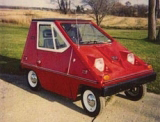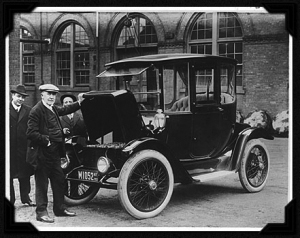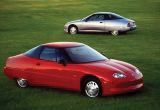 If you believe electric vehicles are a new technology, think again
If you believe electric vehicles are a new technology, think againTHE HISTORY OF THE ELECTRIC CAR
By Alison Lakin, Associate Editor
The Car Care Council
 If you believe electric vehicles are a new technology, think again
If you believe electric vehicles are a new technology, think again
Part I: 1830-1930 • General Motors EV1
Their widely unfamiliar history actually pre-dates that of gasoline powered cars. In fact, it takes going back as far as 1830 – that’s no typo – to start uncovering their spotty past.
During that decade, a Scottish lad by the name of Robert Anderson assembled a crude first electric carriage powered by simple primary cells, and Thomas Davenport, an American, built the first electric motor. In the 20 years following Davenport’s death in 1851, people began to realize the magnitude of his invention and between then and 1880, his machine was used to power mass transportation vehicles like trains and trolleys.
It wasn’t until 1891, though, that William Morrison of Des Moines, Iowa created a successful electric automobile. His car had 4 horsepower and, similar to the restricted speed of EV city cars nowadays, a top speed of 20 mph. The battery’s charge only lasted about 50 miles.

Just a few years earlier, the EV’s arch nemesis, the internal combustion engine, was being developed by a few ingenious Germans named Gottlieb Daimler and Karl Benz. Their last names should sound pretty familiar to you. Daimler fit a gas engine within a stagecoach body to create the original four wheeled vehicle, but Benz hit the historical jackpot and is generally recognized as the inventor of the first practical automobile in 1885.
However, the EV’s cleanliness and quietness compared to the gas engine’s dirty working parts made the EV the quick favorite. The first electric car heyday soon followed leading to electric taxis hitting the streets of New York in 1897 and EVs making up 28 percent of cars on American roads by 1900. That first taxi service was started by the Electric Carriage and Wagon Company using just a dozen electric cars. Feel free to curse their name when that cab’s horn jolts you awake at 4 am.
The same year taxis began roaming the streets, the Pope Manufacturing Company of Connecticut became the first large scale electric car manufacturer in America. In 1900, Canadian Motors Limited produced the Motette, a small two seater, for about three years; and around the same time, Henry and Clem Studebaker entered the electric car market with a light runabout before switching to internal combustion cars six years later.
Martin Eberhard, founder and former CEO of Tesla Motors and electric car history buff, says, “These early electric cars were primarily marketed toward women and professionals like doctors. No hand crank meant that you could drive them without getting dirty or exerting much effort. EVs were successful because they had a niche.”
So what happened? Why are we just now struggling to build EVs again? A few factors contributed to the electric car’s downfall and the rise of the internal combustion engine, many of which are no longer problematic issues.
First of all, there was a growing acceptance of the gas powered car. In 1912, Charles Kettering of Cadillac invented the electric automobile starter eliminating the hand crank starter for gas engine cars that many people found so cumbersome. The first filling station cropped up in St. Louis in 1905, and Seattle saw Standard Oil of California (now Chevron) build its first in 1907. By 1920, gas stations were making their way across the United States making fueling up a car as easy as buying a pint of milk.
In turn, electricity wasn’t as obtainable within America’s infrastructure as gasoline had become. While urban areas were beginning to use more electricity at the turn of the century for appliances like street lamps, only the wealthy were having it installed throughout their homes.
Once one ventured out into more rural areas electricity was virtually non-existent forcing drivers of electric cars to stay close to home.
To combat that issue large cities like New York had “swapping stations” for batteries. Eberhard says, “These swapping stations, popular around 1910, were a result of the ‘Spheres of Usefulness’ concept. They believed that different vehicles served different purposes. The sphere of electric vehicles was within the city while gas vehicles could go between cities. The trouble with that theory was that the gas vehicles could easily infringe of the EV’s sphere, but not the other way around.”
When they did charge the lead acid batteries at roughly 20 cents per kwh (about $2.07 today), electricity was more expensive than filling up with five cents a gallon gas back then. It’s no wonder people made the switch to the internal combustion engine.
With Henry Ford’s Model T making its first appearance on the roads in 1908 and selling over ten thousand in that model year alone, people had even more reason to drop the electric car. What separated Henry Ford’s gas powered cars from EVs was their relative low cost. Previously, cars had been a luxury for the wealthy, but Ford opted to lower the cost of his car to generate more sales and did this by applying assembly line production in 1913. A change of this magnitude meant sales of more than 308,000 Model Ts in 1914 striking a deathblow to the electric car.
PART II: 1960-2003
Now, jump in your time machine and head to the 1960s when interest in EVs started to increase due to environmental awareness and a desire to remove America from the clutches of international oil dependency. A few attempts were made to get electric cars off the ground, most notably the 1974 debut of the 36-48-volt Vanguard-Sebring CitiCar. Similar to most EVs of the time, it had a top speed of around 40 mph and a range of about 40 miles. Another product of the 70s was the Elcar Corporation’s Elcar with a top speed of 45 mph and a 60 mile range. Both saw promising sales in the middle of the decade, but went kaput once the oil crisis stopped being, well, a crisis.
Pressure to act on the emissions problem begins to build in the early 1990s, and the U.S. government responded with the 1990 Clean Air Act Amendment and 1992 Energy Policy Act. That hippie filled state of California, trending ahead of the curve as usual, passed the Zero Emissions Vehicle Mandate requiring two percent of the state’s vehicles to have no emissions by 1998.
This mandate forced automakers into hurriedly throwing together EVs. So, a few thousand electric cars make an appearance in America’s market during 1998-2003: Honda’s EV Plus, GM’s EV1, Ford’s Ranger Pickup EV, Nissan’s Altra EV, Chevrolet’s S-10 EV and Toyota’s RAV4 EV.
In March of 2003 the Zero Emissions Vehicle Mandate was rewritten and, states Eberhard, “provided a loophole that gave companies a way out. Their fuel cell programs were just a way to break even with the mandate and within a week of the change every EV that was on sale was suddenly off the market.”
In recent years we’ve been made acutely aware of our Earth’s adverse reaction to carbon dioxide emissions. While we are now starting, once again, from scratch to build up the electric car’s market presence, the 170 years worth of attempted EV ventures have given us enough experience to create some amazing and freeway legal EVs.
